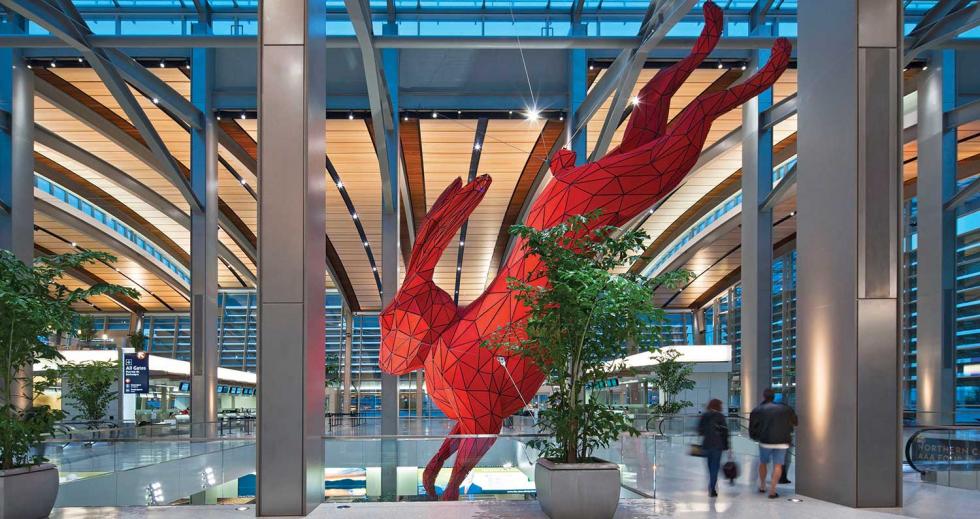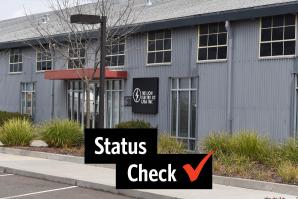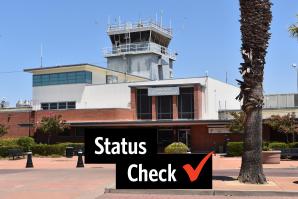When Cindy Nichol, director of the Sacramento County Airport System, stepped into her job in October 2018, Sacramento International Airport was in rapid ascent. Following six years of steady growth, the airport again saw ridership surge. In 2019, passenger traffic rose by more than 1 million over the previous year, representing a 9.3 percent increase. After the first two months of 2020, the airport was on track to again clock a 1-million-passenger jump.
Instead, the COVID-19 pandemic grounded much of the airline industry last spring. In April 2020, the number of passengers plummeted almost 94 percent compared to April 2019. That severely threatened Nichol’s department because passenger volume and services such as parking, concessions and car rentals are directly responsible for 45 percent of the airport’s revenue. Nichol says the losses were somewhat offset by a 21.8 percent increase in cargo traffic at SCAS’ airports, attributable to the surge in online shopping and the demand for quick deliveries. Although some business has returned to Sacramento International relatively quickly compared to other U.S. airports, Nichol says, it closed 2020 with the number of passengers down nearly 58 percent.
Barely surviving a pandemic catastrophe was traumatic, Nichol says. “It was the hardest thing I’ve ever done in my life,” she says. “We don’t have a backstop. … If we don’t cover our costs, we are in default. … The threat was there.”
Unlike most county departments, the airport does not receive money from the general fund — it operates much like an independent business. So Nichol and her team cut operating expenses by $1.5 million by freezing hires and eliminating employees’ travel budget. And a much bigger cost savings came from a couple of smart financial moves. Nichol, with more than 30 years in the airport business and a master’s degree in transportation economics from the Harvard Kennedy School, oversaw two debt-restructuring schemes that will result in tens of millions of dollars in cost savings.
First, the airport was able to refinance $80 million worth of debt at a rate of 2.1 percent, which, Nichol says, will save $2 million a year through 2041. A second more complex maneuver will save the airport almost $2.5 million in fiscal 2021-22 and could ultimately result in much bigger savings.
In May 2020, the airport received $49.9 million from the federal government through the Coronavirus Aid, Relief, and Economic Security Act. Sylvia Ambrogio, the deputy director of finance and administration of SCAS, directed $34.5 million to “defease” two bonds. “This is like paying down your mortgage,” Nichol says, “but it doesn’t just pay debt service, which includes interest, it reduces your principal. So for two fiscal years, we completely eliminated a significant portion of our debt.”
The defeasance eliminated the combined principal of two bonds, which would have come due in fiscal years 2021 and ’22, for a total savings of $17.8 million per year. It reduced the interest associated with that principal as well by $1.65 million and $800,000, respectively, according to SCAS spokesperson Samantha Mott.
“COVID has been horrendous — all of us have suffered losses, including me. But the silver lining for us is that it has given us breathing room so that we can now plan our needed facilities in a logical way and phase development more than we were going to be able to.”
CINDY NICHOL Director, Sacramento County Airport System
Nichol says she’s happy that the savings, plus the remaining $15.4 million in CARES Act money, allowed the airport to avoid staff layoffs and furloughs, and she does not anticipate that either will be necessary in the near future. The airport also gave rent breaks to its major tenants, none of whom were forced to close, and deferred the annual minimum payments it ordinarily charges concessionaires.
Nichol is eager to get back to work on the ambitious initiatives she launched when she took her job. She points out that the forced break triggered by the pandemic was, in one important way, a blessing in disguise.
“COVID has been horrendous. All of us have suffered losses, including me,” she says. “But the silver lining for us is that it has given us breathing room so that we can now plan our needed facilities in a logical way and phase development more than we were going to be able to.”
Nichol is referring to a project she worked on throughout her first 18 months on the job, the SMF Master Plan 2020 Update, which looks out to 2041 and envisions significant continued growth for the airport.
Always Aiming High
The ambition that Nichol brings to her job seems to fit the airport’s legacy. When the idea of relocating Sacramento Municipal Airport from the airfield now known as Executive Airport to the rice fields north of the city, some folks saw it as a pipe dream. Critics did not see how Sacramento, a city with a population of barely 200,000 in 1957 when the 6,000-acre parcel was purchased, could support the airport that was being proposed. The property was seen as too big and the project too expensive. Projections that 750,000 people would use the airport in its first year were laughed at by critics.
From the moment Sacramento Metropolitan Airport, as it was called then, opened in October 1967, it was a hit. In its first year, 1 million travelers passed through its gates. The ensuing decades saw ups and downs, but as the region grew and Northern California became more popular as a tourist destination, the airport’s numbers continued to trend upward. Spurred by this growth, the airport built a second air cargo facility in 1985 and a second runway in 1987.
Over the course of the early 1990s, several carriers brought their operations to the airport, while some others left, resulting in a net gain. In 1993, the scruffy low-cost carrier Southwest Airlines, which was launched the same year the new Sacramento Metropolitan Airport opened, arrived. It has since become the largest domestic carrier in the United States and is responsible for more than half of the passenger flights in and out of Sacramento International.
In 1998, a new Terminal A was built, and the airport rechristened itself Sacramento International Airport. Notable to airport history buffs: Terminal A became home to the world’s first consolidated rental car center, in which all rental car companies are situated in one building, connected to the terminal by shuttle busses. This is now an industry standard.
Meanwhile, in September 1993, Mather Air Force Base, east of Sacramento in then-unincorporated Rancho Cordova, was decommissioned, and the majority of the base was transferred to Sacramento County to operate. In 1995, the airfield reopened as Mather Airport. And Mather brought SCAS an asset that has proven to be valuable.
Mather, which was rebuilt in 1941, was designed to handle the Boeing B-52 Stratofortress — a long-range, eight-engine bomber that weighs 390,000 pounds and can carry a 70,000-pound payload. Fully loaded, the B-52 needs a long runway for takeoff, and while the big birds are gone, the 11,300-foot concrete runway the behemoths required is still there and is more valuable than ever. In hot summer weather, it takes a heavy cargo plane a long time to get off the ground. To compensate, cargo carriers often need to cut their loads. Mather’s runway allows cargo planes to take off fully loaded — a definite money saver.
Sacramento International Airport features several distinct pieces
of art, including “Leap,” a 56-foot aluminum rabbit that greets
passengers in Terminal B.

SCAS’ biggest advance was launched in 2006, when planning began for The Big Build — the replacement of Terminal B, the largest capital improvement project in Sacramento County history. The department pushed for a bold plan, and, again, critics were dubious. Some saw the $1.03 billion project as a boondoggle: too big, too expensive and too optimistic in its ridership predictions.
When Terminal B opened five years later, most of the ambitious ideas had been realized, and it included a number of innovations. Three times the size of the old Terminal B, its setup was somewhat unique: The terminal and concourse buildings are connected by an automated people mover.
Designed by Corgan in collaboration with Fentress Architects — the company that revolutionized airport design with Denver International Airport in 1995 — Terminal B’s curving roofline, abundant glass and clerestory are meant to evoke the Central Valley’s sunshine and Sacramento’s tree canopy. With an eye toward sustainability, the high-tech glass keeps the valley heat out, and recycled materials were used throughout the building process, including salvaged wood for the modern cathedral-like ceiling.
Having opened two years after the Great Recession, it took a couple of years for Terminal B to look like a slam dunk. But in 2013, passenger numbers began an upward climb, which has gotten steeper almost every year since.
Sacramento Takes Off
While aviation economics can be complex, Nichol says the reason for Sacramento International’s recently interrupted string of growth years is simple. Airport passenger numbers generally track with an area’s gross domestic product, and the Capital Region’s economy was on a steady upswing.
Sacramento County Supervisor Phil Serna, who lives in and represents the district in which the aiport is located, says the region’s economic growth may be reciprocally tied to the airport’s success. “It might be serendipitous,” Serna says, “but we had a renaissance underway in downtown Sacramento, the build-out of one of the newest suburban areas, Natomas, and simultaneously the completion of a new international airport terminal. The fact that you can get in and out of the airport easily, enjoy the public art — it’s just a pleasing experience. And I think it reverberated, and it’s become a point of pride throughout the region.”
Serna says the airport serves passengers from beyond the 10 counties of the Capital Region. Airport spokesperson Mott concurs, and points out that, uniquely for Northern California, Sacramento International has an entire region to itself. “When you think about the Bay Area,” she says, “(San Francisco International), Oakland and San Jose (airports), while not all that close together, they serve overlapping regions more than Sacramento does with any other international airport.”
Mott says in “battleground” communities, such as Napa and Modesto, where passengers have a choice, Sacramento International continues to compete well because of the relative lack of traffic, cheaper parking, and easier ingress and egress.
“The fact that you can get in and out of the airport easily, enjoy the public art — it’s just a pleasing experience. And I think it reverberated, and it’s become a point of pride throughout the region.”
PHIL SERNA Sacramento County Board of Supervisors
The Master Plan 2020 Update calls for expansion of many of the airport’s facilities, including additional gates, check-in facilities, security checkpoints and baggage handling systems. Improvements are planned for multimodal transportation options such as the driverless tram that shuttles passengers from the terminal to the gates. And Nichol predicts that the airport needs to plan for new, as-yet-unseen technologies, pointing to the disruption — both positive and negative — that ride-sharing apps triggered.
The update, which was initiated before the pandemic, projected that boardings could increase from 6.6 million to more than 11 million by 2038. A recent Forecast Summary predicts that it may take five years for the airport to get back to 2019 peak numbers, and that development projects enumerated in the plan, would experience a five- or even 10-year delay. And yet, at a virtual public meeting on the plan, a spokesperson said, “It is also possible that recovery from the current situation could be more robust, and projects will be required sooner to meet the needs of airport users.”
Nichol is unabashedly optimistic. Where some might see a lingering reluctance to fly, she sees pent-up demand. “What we’ve seen in our recovery so far has come more from leisure travelers,” she says, “and we know some business travel will return. I believe people will travel more, because as we are being reminded, sometimes you’ve just got to be there.”
–
Stay up to date on business in the Capital Region: Subscribe to the Comstock’s newsletter today.
Recommended For You

Status Check: McClellan Park
Electric school bus company that moved to the development in December may temporarily close due to coronavirus
The coronavirus has upended operations for businesses around the Sacramento region, including Lion, which was founded in 2008 and operates and repairs all-electric school buses.

Flying High
Sacramento County Airport System Director Cindy Nichol on rapid growth and planning for the future
Cindy Nichol became director of the Sacramento County Airport System in October 2018, bringing more than 30 years of experience in airport management to the position. Her career includes stints at San Francisco International Airport and the Port of Portland. Comstock’s recently spoke with Nichol about the four-airport system she oversees.

Status Check: Sacramento County Airport System
Sacramento County Airport System uses $49.9 million in CARES Act funding to offset traffic decline from COVID-19
The pandemic has upended normal operations for the four airports, but stakeholders see reasons for optimism.

Let’s Toast a Return to Prosperity for These Two Industries
Comstock’s executive editor predicts the recovery of the wine and travel industries.




